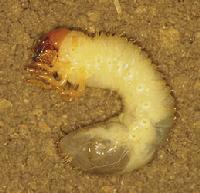 Here is how you can control white grubs safely:
Here is how you can control white grubs safely:
 Here is how you can control white grubs safely:
Here is how you can control white grubs safely:
White grubs are the larvae (children) of scarab beetles. Most in Ottawa-Carleton are "June bugs" (Phyllophaga spp.), but some are Japanese Beetle and every few years (as in 1999) there is a population peak of European Chafer Beetle. They eat grass roots.
By the time the damage to your lawn is apparent, it is too late to correct the problem for this year. The roots have already been eaten. You have to concentrate on next year's lawn. Begin by overseeding.
If you have too many white grubs, they are telling you that your lawn is unhealthy. Nearly always, they are telling you that you are using too much fertilizer. Your grass roots are weak and soft - a salad for grubs, especially when the hot dry summer comes. Healthy soil, with nutrients released slowly by decomposition, lets grass roots grow steadily all year. "Green-up" fertilizers, particularly the liquid ones, force the grass to grow far faster than it would naturally.
The first step is to reduce your use of artificial fertilizers. Local organic turf specialists apply far less nitrogen than is recommended on most fertilizer bags. Mow high, often and lightly, and leave the clippings on the lawn - they are the best slow-release fertilizer there is for your grass.
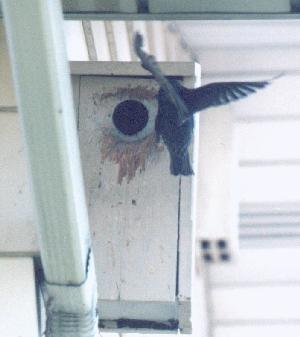 Then, water no more than once a week, but water deeply when you do, so your grass roots
grow deep and strong. Put a container on your lawn when you water, and don't stop until there
is at least 2 cm of water in it. For most sprinklers, that takes a full hour.
Then, water no more than once a week, but water deeply when you do, so your grass roots
grow deep and strong. Put a container on your lawn when you water, and don't stop until there
is at least 2 cm of water in it. For most sprinklers, that takes a full hour.
If you don't use insecticides, put up a nesting box for starlings. They raise their young on white grubs and, with their sharp yellow bills, make only tiny holes in the turf to get them. (Skunks eat them too, but leave paw-sized holes.)
If you have sprayed your lawn with insecticides within the past few years, you will have killed most of the natural parasites of white grubs. You can help to redress this imbalance by restoring the natural nematode population of healthy grassland. (Cold-tolerant strains are available at several local garden centers.) They are a waste of money, though, unless you plan to stop using insecticide sprays for good.
Non-toxic, bird-friendly, lawn care works. See our brochures on Ecological Lawn Care and Ground Covering Plants for more details.
Provided by the Health Dangers of Urban Use of Pesticides Working Group of the Region of Ottawa-Carleton, Ontario Canada. Approved by Regional government and by the Ottawa-Carleton Health Department. Please feel free to copy.
PEN footnote:
| 2001 was a bad year for grubs in eastern Ottawa. This is the back yard of my only neighbour who relies on spray truck technology. His grass roots go barely 2" deep and look like bean sprouts. | 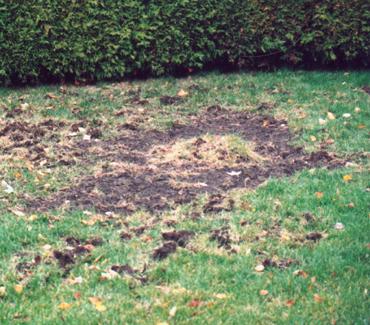
|
| This is my back yard, on the same day. I rely on overseeding, proper cutting, starlings, clover, and nothing else. My grass roots go down 6" and are as tough as barbed wire. I have just as many grubs as my neighbour, but the only bare patch I have is in front of my favourite chair. | 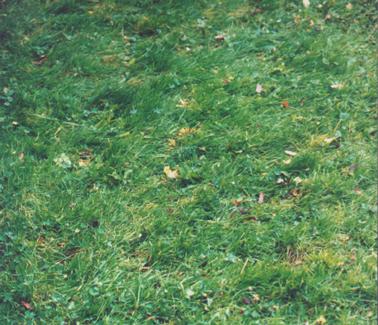
|
| 2001 was a dry year in Ottawa. Here is how the road verge of my only neighbour who relies solely on spray truck technology looked by September 2001. | 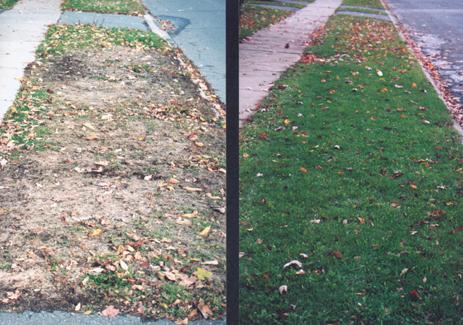
| Here is the verge of another neighbour, on the same day. He applies a light application of granular fertiliser spring and fall, and mows properly - his wife digs up the dandelions. |